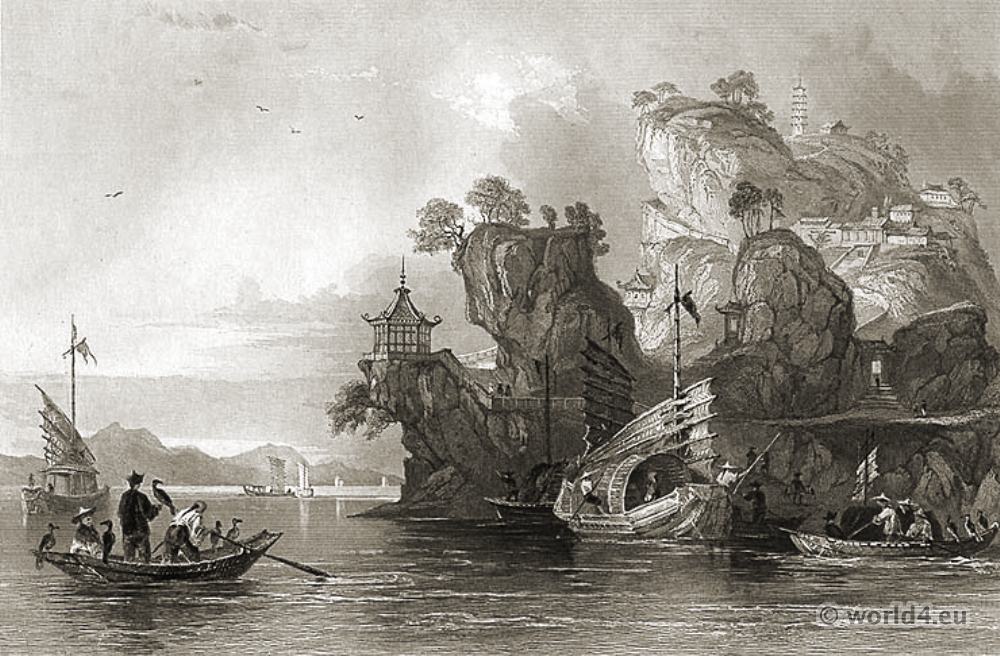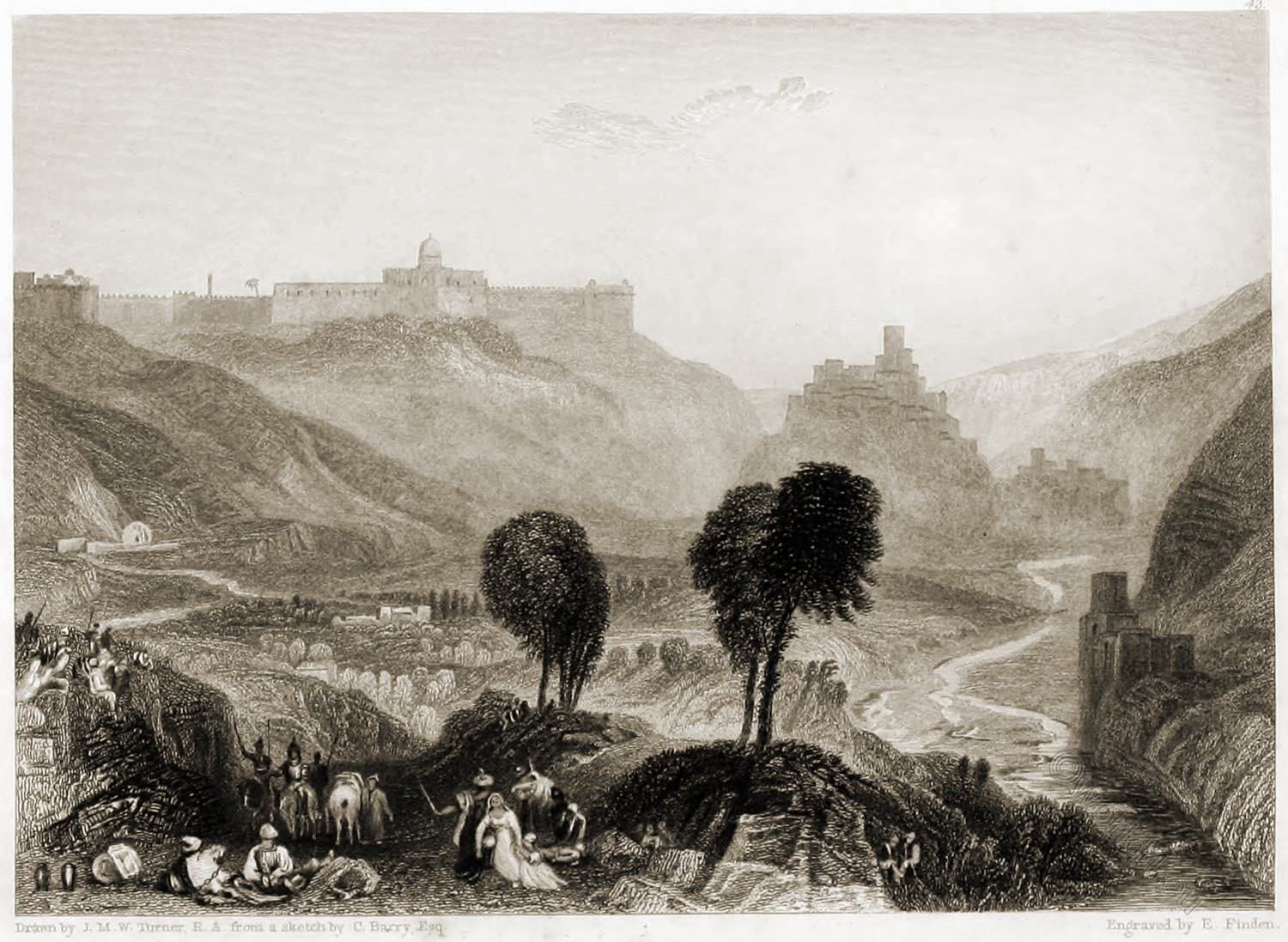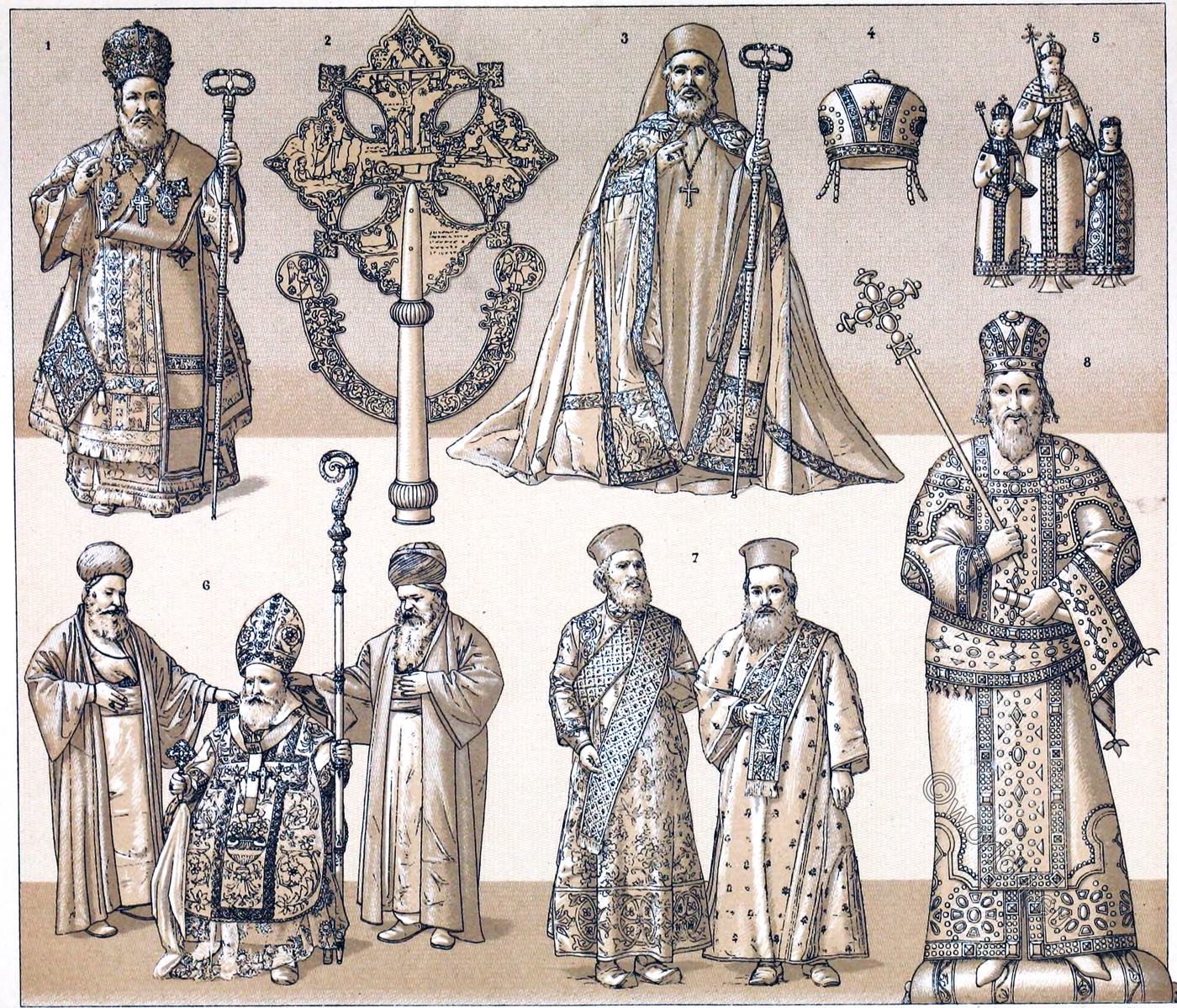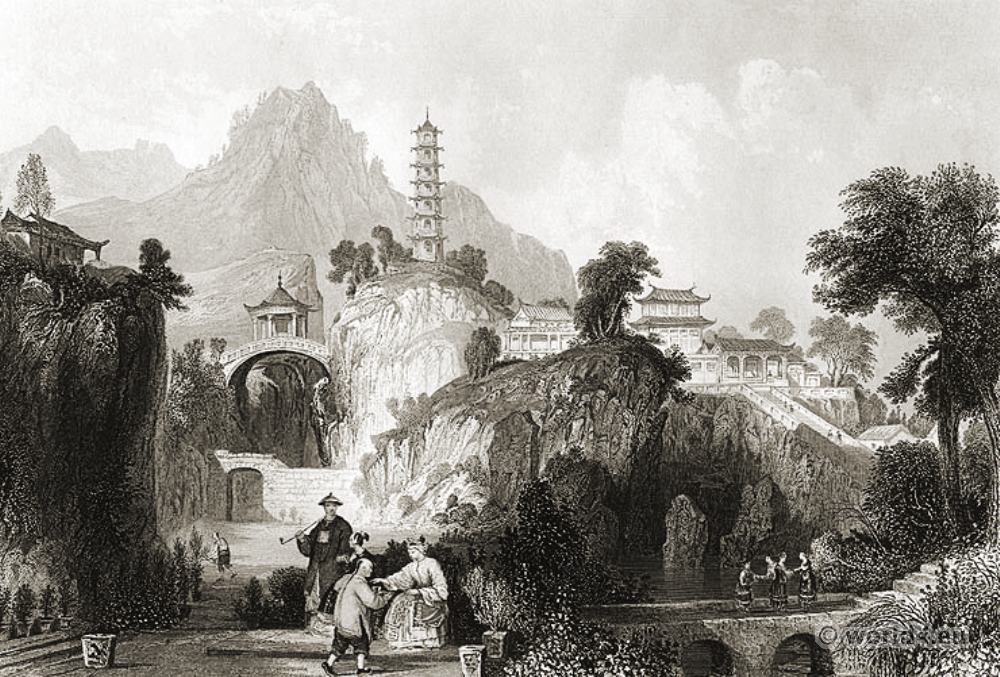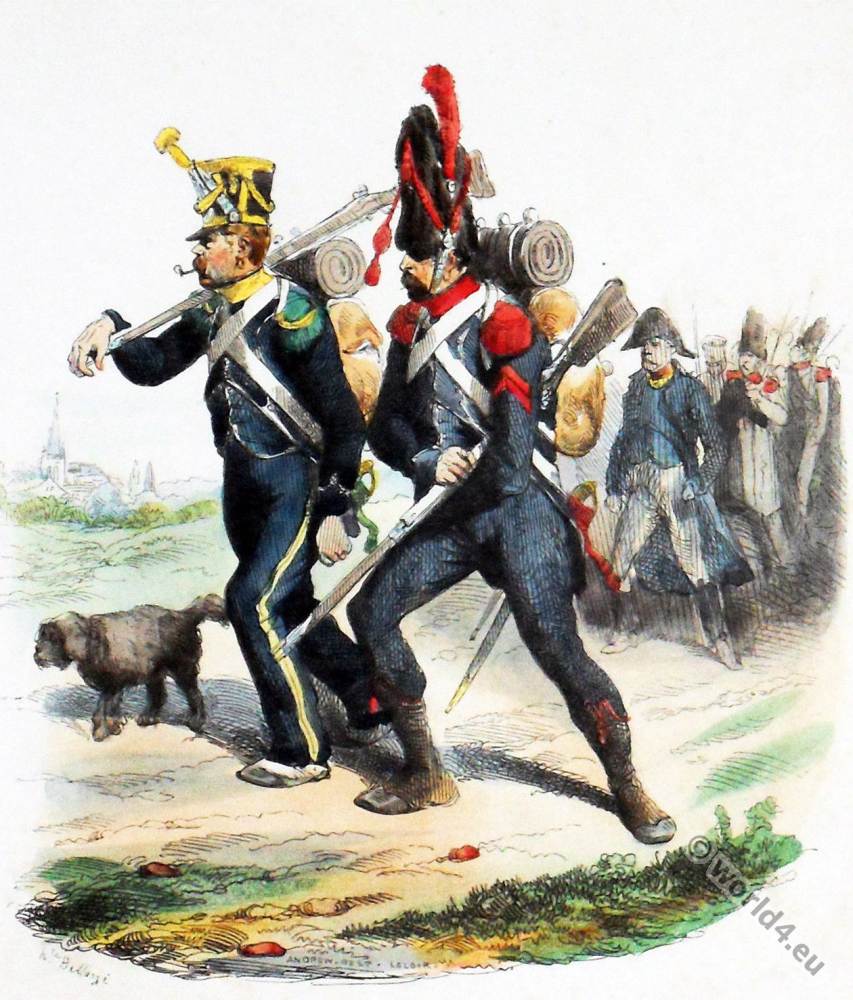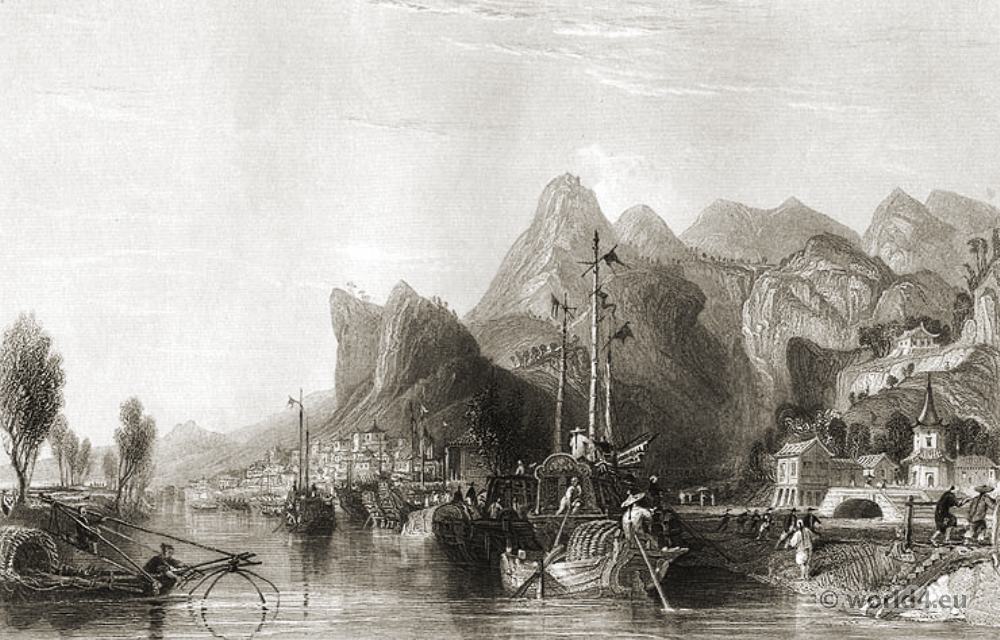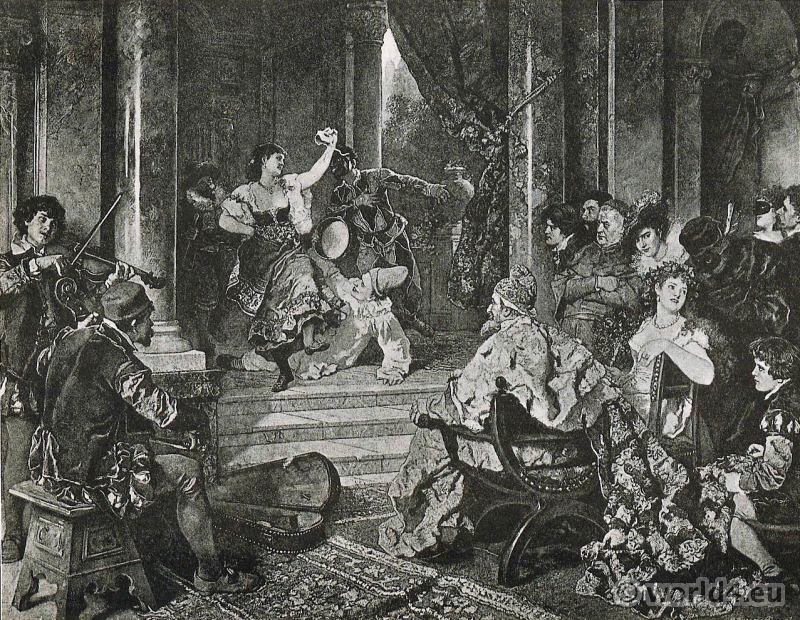The Imperial Palace at Ts’ao shan.
About three miles north-east from Chin-keang-foo, the provincial capital of Jiang Nan (Chinese: 江南;), from the broad bright waters of the Yangtse keang, rise the picturesque and precipitous rocky islets called “the three hills of King-kow.” Nature has been beautiful to them in all respects, and, from immemorial time, they have also largely partaken of the smiles of their imperial rulers.
These are the “Kin-shan,” or “Golden Island”-the “Pib-koo-shan,” and “Tseaou-shan.” The first, perhaps one of the most romantic and agreeable localitiea in the empire, was anciently called “the Floating Jade,” but auriferous veins being discovered in its rocks, it received its prevent appellation. Here also is a fountain of the purest water, from which the mandarins of the surrounding country are supplied, and a faithless messenger, who once endeavoured to impose upon lie-tth, the imperial prime-minister, by substituting water from a well at Shih-tow, for the crystal draught of the “Chung-ling,” paid the penalty of his indolence and temerity. Near to the summit of the Kin-shan is the celebrated mound of Pei-tow, of the Tang dynasty; while, impending over the Pool of the Dragon King, and close to its shores, is the Shen-tsae rock.
The Tseaou-shan rises with even more abruptness and varied forms than the Kin- shan. Enclosed by high cliffs, landing can only be effected at one point, where means of debarkation have been formed in the rocks, and whence communication with the palace, the temples, and different buildings on the island is obtained by flights of countless steps. Tseaou-yin-sze-kwang, the recluse Tseaou-kwang, or Tseaou-seen, a mandarin of ancient ancestry, in the district of Hotung, of profound learning and austere habits, and who lived about the close of the Han dynasty, suddenly renouncing society, withdrew in secret from the imperial capital to a concealed asylum on a little island amidst the waters of the great Keang, that now records his name.
On this island he dwelt in the utmost seclusion for many years, a devotee, or, more properly, a misanthrope-the locality of his hermitage being kept secret from his former associates, his relatives, and his friends. He here erected a cell or chapel, which still remains; and close by it he built a lowly hut of turf, and thatched it with matted grass. To guard still further against the chance of discovery, he laid aside his appellation of Heaou-jen, and adopted that by which he is known to the story-tellers of his country. In this sequestered spot he might have passed his useless and inglorious life, and gone down unnoticed to the tomb, had not an accidental fire destroyed his home, and disclosed to the navigators of the river the presence of an inhabitant of the rock.
After this event he was seen wandering from crag to crag almost in a state of nudity, and often observed reposing, amidst the winds and the snow, upon the unsheltered earth. His real rank and character being now ascertained, commissioners from the emperor landed on the islet, and proceeding to the glen chiefly frequented by the recluse, there summoned him to return to court by an edict three times repeated. Their invitation was unavailing; Tseaou had forsaken the busy haunts of man, and the ambassadors returned with his refusal to their illustrious master. The scene of this interview is called in commemoration, “The San-chaou-tung,” or “Ravine of the Three Citations,” and around are seen a number of upright stones standing at regular distances, which legends call “the Councillors of Heaou-jen.” To those who have visited that singular pagan relic in Cornwall, called the Hurlers, the scenery of the Ravine of the Three Citations will be at once familiar.
Tradition or legendary lore is not the sole authority on which the story of Tseaou’s hermit life depends; his biography has been carefully collected by Tsae-yung, who wrote the narrative of his long concealment.
Nothing can exceed the picturesque irregularity of the surface of this isle; and, 80 established has this eentiment of admiration become in the empire, that a mural tablet at the gate of the temple of Tsin-tse declares this rock to be “the first and the fairest of all the hills on earth,” Too-woo-kung being subscribed as the author of this brief but laudatory memorial. Ascending the rocky flights that lead from the landing-place to the grottoes in the hill, the words FOW YUH are perceived cut in the tall cliff in characters large and legible, graven by Chaou, who flourished under the Sung dynasty. Immediately in front of this “handwriting on the wall,” another projecting crag is inscribed ” SHIH-PING,” (the Rocky Screen,) and this characteristic name sufficiently describes the value of the eminence as a protection against the winds that sweep across the river’s course from north to south.
Tseaou’s chapel, which lends its still-abiding form to verify the tales of tradition, is known as the “Kwan-yin-kS” or “Gallery of the Goddess of Mercy;” in front is a rich plantation of bamboos, between the pillary stems of which the graceful form of the Golden Island may be traced. On the eastern slope of the island stands the ” Keih-keang-ting,” Drink-river Hall, the site of an ancient pagoda which was destroyed by fire in the reign of Hung-woo, the first emperor of the Ming dynasty, which preceded the present Tsing or Tartar; a Hall of Ancestors, was erected from its ruins. On the highest peak ie the ” Ta-pei-ting,” or “the Shen-tsae Hall,” belonging to the Sung dynasty; its site was anciently occupied by the “Lo-han-yen,” that is, the mountain-terrace of the immediate disciples of Buddha. This title the emperor Le-tsung, of the Sung dynasty, caused to be written ” in three large characters” to attract the attention of after ages.
From this very elevated station the view of the three islands, of the picturesque and unequal country around Chin-keang-foo, of the winding waters of the Yang-tze-keang, and the vast extent of landscape which the coup-d’oeil comprehends, is unrivalled in all the central provinces; here, says a Chinese topographer, ” the eye in the heavens has no limit but the span of the clouds–nor on the river, but the wind-blown sail.”
Hallowed by antiquity, reverenced from its religious or superstitious associations, and wrapped in all the interest that the most romantic legends can impart, the imperial ruler of the Chinese, with an admirable taste, directed that ruin should withhold its ravages amidst the walls of the pagoda, and chapel and hermitage on Ts’ao Shan; that the ancestral halls should be restored, and apartments suitable for the reception of majesty, during official visits to the province of Keang-nan, be constructed and maintained. This felicitous command has been complied with: and the emperor, in the spring apd autumn of the year, enjoys the refreshing breezes from the Yang-tse-keang in his gay pavilion on the rock, or witnesses from its casements the sport of fishing with the trained cormorant. “We saw,” says a modern traveller, “on the Paou-ying-hoo, an extensive swamp or lake on our right, five or six boats crowded with the fishing-birds, which they called Yu-ying, ‘fishing-hawk,’ and others Yu-ya, ‘fishing-duck,’ ‘without much regard to physical accuracy.
We prevailed on one of the men to bring his boat close to the shore, and had a narrow view of them. They stand about as high as agoose, but are not so heavy in make, with a very long bill, the upper mandible of which is hooked at the end, like all birds that prey on so slippery a subject as fish. Their colour on the back is darkish, approaching to blacky and they appear to be something between a pelican and a cormorant. The people were very unwilling to sell them, and with sufficient reason, as the difficulty of training them for the service of the fishing-boats tnust be considerable. They were all secured by the leg, and some had a ring fastened loosely round the neck to prevent their gulping the fish.” To the ring a cord is attached, also tied to one of the egg, and whenever the diver loiters, he is pulled towards the boat, into which he is lifted by a long bamboo cane having a hook at the end of it. The bamboo, after the manner of Chinese legislation, is frequently applied to the cormorant’s back whenever he becomes lazy, and its effect in sending him down ie instantaneous.
Tseaou-shan is readily distinguished from the two islands adjacent, not only by its rude rocky stages, but by a number of large characters cut in the cliff, a little above the water-level, and known as the Eu-ho inscription, as well as by two tall slender rocks, resembling the Needles off the west end of the Isle of Wight, which the Chinese call Haemun, “the Sea Gate,”
Source: China, in a series of views, displaying the scenery, architecture, and social habits, of that ancient empire. Drawn, from original and authentic sketches, by Thomas Allom. With historical and descriptive notices by the Rev. G. N. Wright.
Related
Discover more from World4 Costume Culture History
Subscribe to get the latest posts sent to your email.

